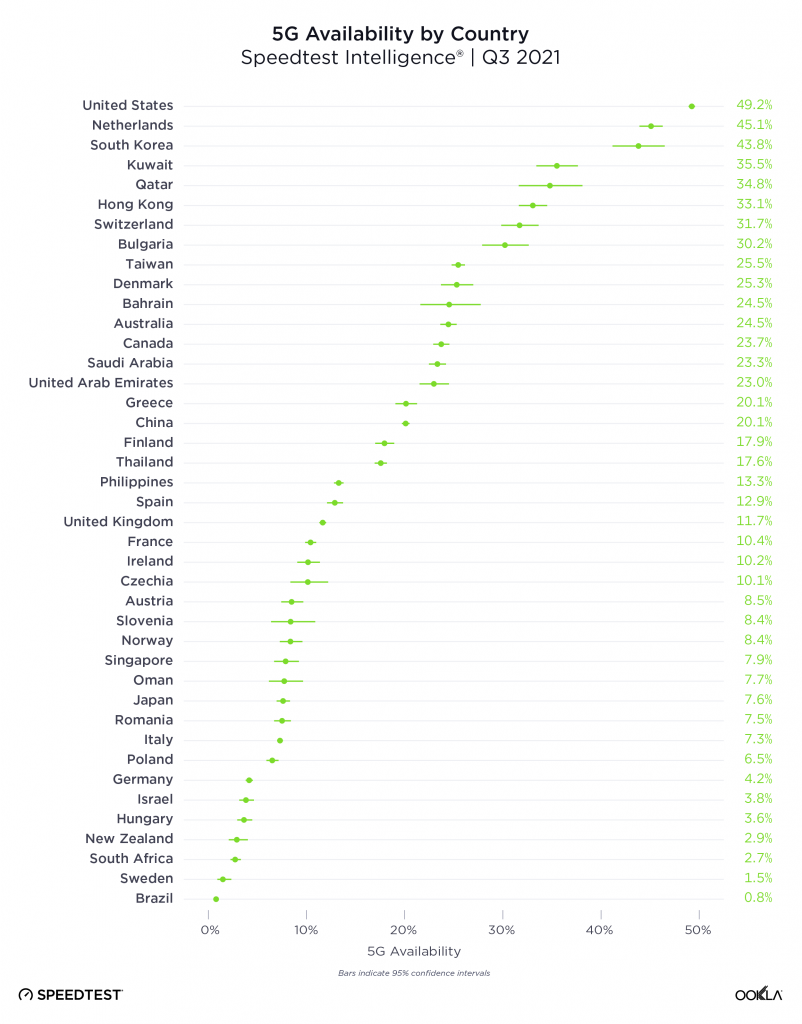The state of 5G in the US is bafflingly confusing. The country boasts a high coverage against its population and maybe a few countries to achieve so. When it comes to the speed though, it falters and it does so big time. The perplexing condition is backed up by the latest report by Speedtest.
AT & T, T-Mobile, and Verizon have all taken their 5G nationwide. T-Mobile recently trumpeted reaching 200 million people aided by its mid-band 2.5 GHz spectrum and is keen on reaching 300 million by 2023. AT & T claims they have the “nation’s best 5G” and connect above 250 Million users on their 5G network across the country. Verizon also has similar figures to take pride in its 5G service.
The US Leads in 5G Coverage
Under the ‘5G Availability’ category, Ookla analyzed what percentage of the people in various countries has 5G coverage. Its report found that 49.2% of the people in the US have 5G coverage while Holland followed second with 45.1%. South Korea followed at third with 43.8%. Kuwait and Qatar made it in the top 5 with 35.5% and 34.8% respectively.

But strikingly, 16 countries hit below 9% for the 5G coverage that included countries like Austria, New Zealand, and Brazil. 8 countries were on the list with 10% and above to below 20% coverage that noticeably included the countries like Finland and UK.
But not so with the speed
While the US remains a global leader in terms of 5G coverage, it doesn’t hold the same when it comes to broadband speed. Ookla studied the 5G speed of 11 countries which were the early movers with the fifth-gen cellular network under its Q3 SpeedTest.
Here, South Korea led atop with a median speed of 492.48 Mbps whereas the bottom 10% also clocked 151.52 Mbps. Firing at above 400 Mbps download speeds were Norway and UAE at second and third with 426.75 Mbps, and 409.96 Mbps respectively. Their bottom 10% speeds averaged 110.77 Mbps and 80.33 Mbps respectively. China has proliferated the world’s largest number of 5G base stations came at fourth with the median download speed 299.04 Mbps (bottom 10% 73.96 Mbps).

The remaining countries’ download speed fared much lower with the UK clocking at 184.20 Mbps among the low-performing countries.
The US with its meager 93.73 Mbps median 5G download speed fell well short of its peers. What’s worse is that it trailed behind all the European countries in the list that all sported above 100 Mbps speed.
Low Speed of 5G in the US Down to Low-Band Spectrum
5G speed is determined by the spectrum it is operating in and the US doesn’t pack much punch in it. The US operators sloped towards the low-band frequency (under 1 GHz) unlike other states where mid-bands were the chosen frequencies.

The carrier providers use low-band for 5G in the US which has a semblance to 4G in broadband capacity. T-Mobile still has 600 MHz frequency in large parts of the US and the same holds for Verizon and AT & T. The low-band 5G doesn’t deliver significantly better performance than 4G LTE.
T-Mobile though has 2.5 GHz to lead its 5G now, but AT & T and Verizon are yet to start with their C-Band (3.7 GHz) frequency. Their use of mid-band (C-Band) frequencies stalled for one month after the FAA concerns that they could compromise with the aviation’s altimeter. But the concerns have subsided and the carriers might move on with their mid-band 5G (3.7 GHz) in the early Q1 2022.
New reports have already emerged showing T-Mobile’s download speeds bump due to the mid-band spectrum (2.5 GHz). One Opensignal report showed that the users who connected to t-Mobile’s 2.5 GHz 5G attained 239.3 Mbps download speed, a massive 40% increase from 170.1 Mbps recorded on its low-band 600 MHz spectrum.
Related: 5G Spectrum Bands: What Do High, Mid, and Low Bands Mean?
5G Speeds Impacted by the Density of Users
But Ookla has offered insights into the discrepancies in 5G speeds. It wrote, “What really seems to separate these markets is the level of 5G network densification. The number of people per 5G base station ranges from 319 in South Korea and 1,531 in China, to 4,224 in the EU and 6,590 in the US, according to the European 5G Observatory’s International Scoreboard during October 2021.”
But Ookla is upbeat about 5G turning it around. “More users are logging on to existing 5G networks, and we’re also at the stage in the evolution of 5G where countries that have historically had slower speeds are starting to offer 5G,” the analysis stated. “While the dip in speeds looks like a letdown, it’s more of a compromise to enable broader access.”
There are still 70 countries that depend on legacy networks and Ookla says these countries need to refarm their available spectrum for 4G and 5G networks. The 5G reach is widening and 2G and 3G won’t stand up to the evolving technologies. They are only sufficient for social media, and basic, voice and texting. For HD video calling, to rich-media consumption, 4G and above is a must.
Check out: 4G vs 5G Mobile Network | Explained
Ookla is optimistic that performance level is normalizing as “5G expands to more and more countries and access improves”.
The 6G hype is already beginning but the 5G promise is yet to be substantiated. Would you believe the network would rebound with more advancements in the technologies? Do share what you think about the declining 5G speed in the US and around the world.
